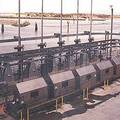電廠冷卻水系統不更新 犧牲大量水生物生命
 生態價值能夠評估得出來嗎?又該如何評估?美國最高法院日前審理一樁老舊電廠規範案件,對此議題正陷入兩難。這起官司的議題是,在制定老舊電廠規範,要求電廠採取限制用水等環保措施以減輕環境損害時,是否允許政府納入「成本效益評估」,讓電廠可以「犠牲不具經濟價值或價值較低的水生生物」。
生態價值能夠評估得出來嗎?又該如何評估?美國最高法院日前審理一樁老舊電廠規範案件,對此議題正陷入兩難。這起官司的議題是,在制定老舊電廠規範,要求電廠採取限制用水等環保措施以減輕環境損害時,是否允許政府納入「成本效益評估」,讓電廠可以「犠牲不具經濟價值或價值較低的水生生物」。
這起官司12月2日在最高法院審理。布希政府官員在口頭辯論中重提2007年被初審法官駁回的要求:希望法院允許聯邦管理機構在考量諸多問題時,以成本效益來分析狀況。多數法官似乎對官員的論調抱持著懷疑,不過,法院似乎有意促成雙方各讓一步的妥協方案。
這起官司完全視淨水法(Clean Water Act)的條款如何解讀而定──淨水法其中一項條款,授權環保機構要求電廠的冷卻水汲取設備,應裝設「最佳可行技術,把負面環境衝擊降到最低。」
這是非常重要的環境議題。因為美國電廠每天從蓄水池、湖泊及河流抽取冷卻水,用來冷卻機器核子反應爐,抽水量超過2000億加侖,同時也把水生生物吸入冷卻水水管中,造成大量魚群及水生生物死亡。
但另一方面,經濟因素同樣也非常重要。雖然新式電廠採用的封閉式冷卻系統能緩和上述問題,但要求老舊電廠翻新設備的話,可能要耗費很大的成本。工業團體抨擊要求老舊電廠採納一般技術條件的規定,可能會造成一些電廠關門或電費升高,他們主張新規定對環境帶來的效益根本不敷成本。
此官司是緣於2004年布希政府曾通過一項法案,允許大約550座老舊電廠選擇其他替代方案,來減少冷卻水系統帶來的環境衝擊,也就是當成本超過效益時,允許他們可以拒絕使用最佳科技。
對此,而六個州和由河流保護協會(Riverkeeper)帶領的環保團體聯盟提出訴訟,聲稱淨水法並未允許環保署在修訂冷卻水引入法規時,增加可採用成本效益分析的條款。目前第二巡迴上訴法庭已裁定原告勝訴,但政府相關機構也因此繼續上訴到最高法院。
The U.S. Supreme Court is wrestling with the difficulty of valuing fish and aquatic organisms with little or no commercial worth, hearing arguments in a legal dispute over what steps older power plants should take to limit water use and minimize environmental harm.
In oral arguements Tuesday, the Bush administration urged the court to allow federal regulators to use cost-benefit analysis when crafting such requirements - a view rejected by a lower court last year.
A majority of justices appeared skeptical of the Bush administration's arguments, but seemed keen to find middle ground that would allow for some considerations of costs and benefits.
The legal issue rests on the interpretation of a provision in the Clean Water Act that authorizes the U.S. Environmental Protection Agency to require power plants install "the best available technology for minimizing adverse environmental impact" from cooling water intake structures.
The environmental concern is a serious one. U.S. power plants pull more than 200 billion gallons of water a day from reservoirs, lakes and rivers to cool machinery or, in the case of nuclear power plants, to cool reactors. The practice kills large numbers of fish and other aquatic organisms that are drawn into intake pipes along with cooling water.
But the economic concern also is considerable. Newer power plants are constructed with closed-cycle cooling systems that alleviate much of the concern, but retrofitting older plants can be costly.
Industry groups contend broad technology requirements for all older plants could force some to close and others to raise electricity prices, all for environmental benefits unequal to costs.
Heeding that concern, a rule finalized in 2004 by the Bush administration allowed some 550 older plants to chose among several alternatives to reduce environmental harm from cooling water intake structures, allowing them to avoid installing the best available technology if the costs outweighed the benefits.
Six states and a coalition of environmental groups, led by Riverkeeper, sued, arguing the Clean Water Act does not allow EPA to conduct cost-benefit analysis when crafting the cooling water intake rules.
The U.S. Court of Appeals for the 2nd Circuit agreed with that view and struck down the regulation, prompting the appeal to the Supreme Court by the Bush administration and several utilities.






